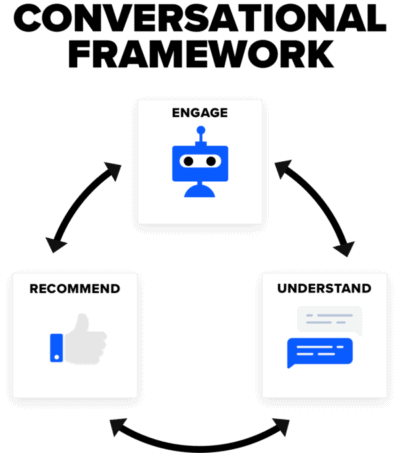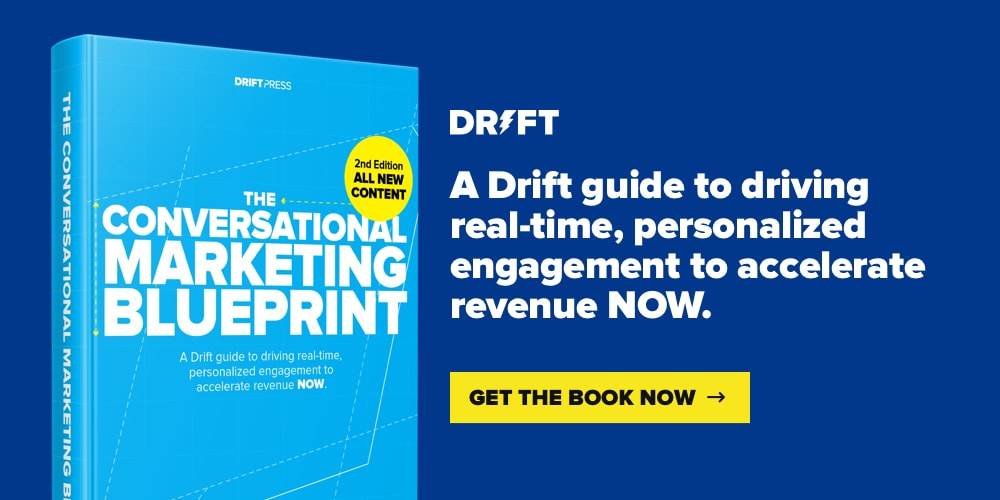Yeah, I said it.
Your potential students (and parents!) are forced to dig through your hundreds and hundreds of website pages to try and find what they need.
Would you ever give a company the time of day if they made it that hard to purchase something from you? The answer is absolutely not.
And don’t give me this:
via GIPHY
College is one of the biggest purchases a family will ever make. But the amount of friction that schools put into the application process? It only contributes to this kind of stress. Now imagine making this financial (and life!) decision in the middle of a pandemic 🤯
That’s what today’s students and parents are dealing with. To respond accordingly, schools need to connect with parents and students in real-time – or run the risk of losing enrollment or future enrollment.
We talk a lot here at Drift about using conversational marketing to accelerate the buyer journey and put the customer first.
In university-speak, that means accelerating the time between a student hearing about your school and applying, and putting your prospective students at the heart of what you do in admissions.
It’s taking what you’re already doing and going digital.
You put so much effort into recruiting top athletes, navigating hundreds of student or alumni interviews, presenting information sessions at hundreds of high schools, processing thousands of applications…so why not make it easier for students to get the information they need online?
If your tour guides can walk campus backwards in a snowstorm, you can make your website easy to use. Consider your website your digital tour guide. Here’s how 👇
Conversational Marketing Applies to Higher Ed
The answer lies in changing how you communicate with your prospective students. We call this the Conversational Framework – but it especially applies to an industry like higher education, where the target audience has never known an analog world.
Here’s what the framework looks like:

The conversational framework has three parts to create a digital tour guide experience:
- Engage: Talk to students where they already are and make it easy for them to engage directly with you.
- Understand: Help students understand your school better. Develop empathy with them by knowing the ins and outs of your applicant pool vs. your ideal student body composition and what makes them tick as people, not just as numbers on a page. Ask questions that guide students and parents to the right resources or section of your website.
- Recommend: Give prospective students an action. Get them to attend an event, book an interview with your team, or submit their application.
So, what does that mean for your school?
5 Questions (+ 5 Tactics) to Implement Conversational Marketing for Higher Ed
Spoiler: It’s the same questions plastered over the door of your English department a.k.a the Four W’s. To implement a conversational marketing strategy, you’ll need to answer Who? Where? What? And finally, why?
Who? Target your audience
You probably already see some differences in your applicant pool vs. your accepted students vs. your final classes. But that may not encompass everyone coming to your website.
Who are you engaging with? Start with unknown visitors vs. known visitors, and then dial down until you get to your ideal website visitor – what does your ideal applicant look like?
Not just in terms of demographics, say, if you’re targeting more applicants from a certain geographic area – but in terms of their behaviors and how much they’re interested in the school.
What are they looking to do? Maybe it’s talking to someone. Maybe it’s answering a question. Maybe it’s learning more about a specific program. You have to know before you can think about redesigning a single page or writing a line of copy.
The best way to know? Ask them. In the moment, while they’re browsing.
You can’t do that with a form.
Conversational Marketing gives you the flexibility to answer the most common questions right away and direct your prospective students exactly toward the information they’re looking for, whether it’s specific to financial aid information or looking for a coach’s contact information.
And it’s not just useful for your applicants. The more specific you engage with your visitors, the more information you’ll learn about them, and the more likely they’ll leave with a lasting impression that your school is the one for them.
Bottom line: Embrace the “secret shopper” mindset and make it easier for people to get the information they need.
Where? Personalize the experience
Once you know who you’re talking to, and what pages your prospective students engage with, you need to start looking outside your website.
Where do your prospective students come from before visiting your site?
I can let you in on a secret: They are not on LinkedIn like B2B SaaS buyers are, that’s for sure.
Evaluate your communications strategy through the lens of your prospective student. Are you communicating on your terms, or theirs? One way to start is with your “Sources” metrics. What offers are you putting out there? What draws prospective students to your site in the first place?
Sure, they may be typing your college name into Google, but more likely than not, it’s word-of-mouth that led them to you.
What does word-of-mouth mean these days for Gen-Z? Texting, messaging apps, and TikTok.
@uf Chad and Emma moonwalking. S/O to our School of Theatre + Dance and the UF College of the Arts!
So why are you asking for their email on every form?
Once you have a prospective student’s email address, you can ask for more and different information each time you speak with them and each time they come to your site. Maybe that’s their phone number to connect them with a student ambassador via text, or maybe it’s their Instagram or TikTok handle so you can engage with them where they hang out on the web.
Go where your students are 🎯
What? Engage your website visitors
We’ve talked already about how most university websites have too many pages that are too long and too complicated for the average prospective student or parent to navigate.
What does your website look like to a prospective student? That’s important because more interactions with prospective students are happening online than ever before.
If you’re not thinking about your website and how it’s performing for you, you’re missing out on a huge amount of applicants, but also conversations and leads.
Remember the ideal applicant we talked about in the “who?” Audit your website with that person’s perspective in mind. Remove old or outdated information and surface the most important information right away.
Take these examples:
These schools have little in common, except that their websites all surface the most relevant content to a prospective student right away. The links to different department sections are easy, and you don’t have to sift through alumni-focused news or giving information to get there.
Everyone obsesses about the inquiry form. We’re constantly debating how many fields to use or how many different types of forms you need, when you can move beyond that by designing a conversational experience. Three ways to get started on your site 👇
- Drill down to the specific pages that matter the most for your prospective students. Which ones are they visiting? What does their behavior look like on those pages? That will help you design a conversational experience that gets them to meet with admissions counselors or program managers.
- Once you’ve identified the most important pages, use a chatbot instead of a form directly embedded onto the page. When someone clicks on that call-to-action, they’re having a conversation instead of submitting a form into oblivion where they don’t know if they’ll get an answer. All they have to do in this scenario is say, “Yes, I’m interested.”
- Or, add a chatbot to the bottom right-hand side of the page to answer questions as they come up, or serve as a direct line to your staff.
Most people skip #1 and #2 and just add a chatbot to their pages and think their work is done. But the thing is, chatbots aren’t a strategy – they’re a tool. Without knowing your “who” and designing the experience tailored to them, you’re just hoping for the best.
That’s like answering “C” for every multiple choice answer on a test, because statistically it has to be correct once in a while, right?
Those don’t sound like great odds to me 🤷♂️
You want to be able to engage as many people as possible, so you can book meetings between prospective students and admissions counselors or program coordinators.
Why? Determine intent from prospective students
Quick question: How many schools did you apply to?
(If it’s only one, congratulations, and I’m more than a little jealous).
Me? I applied to five schools. But today’s prospective college student applies to up to 10 schools on average. 10!
Why would someone apply to your school over your competitors?
I’m starting to sound like a broken record, but it’s the conversations you have with your prospective students.
A great starting point for those conversations are the content you create. Maybe it’s videos from current students and alumni talking about their experiences in a given program, or maybe it’s a few behind-the-scenes TikToks like this one:
@rittigers Out here making moves across campus. #foryou #RIT #RITTikTok #longboard #summer #Lizzo
Content, though, is inherently a one-way activity. You go to a webpage. It’s just you reading the website page. You read an ebook. You watch a video. There’s no way to engage with that content or ask questions about it or try to find content that’s similar.
That’s another place where conversational marketing shines. Implement chatbots across all of your resource pages, your help center, your careers page, and your blog.
That’s where they can make content into a two-way conversation, building trust and educating them about what makes your school special. It doesn’t have to be complicated – here’s an example from our own blog:
The two-way conversations you have is what makes your school brand stand out — and determines who chooses to add your school to their list.
Accelerate your application process 24/7/365
Once you dive into application season, everything feels like it’s happening at once.
Let technology do the hard work for you.
When is the best time for someone to apply?
The best time is always now. If you have a specific window you take applications, then use AI to automatically send reminders or follow-ups to prospective students trying to access your application, to start, or for anyone who has visited the most high-intent pages of your site (like where you post your College Board code, for example.)
If you want to always be ready to talk to a prospective student, particularly the applicants you know would thrive at your university and positively impact the community, you need to invest in the right technology.
Don’t take my word for it, take higher ed guru Dave Marshall from Mongoose: “Drift does an amazing job of helping visitors complete tasks on a website easily and quickly. It gives our clients a simple and effective way to get students and their families the information they need without having to tap the institution’s administrative resources. This makes students and parents happy, while at the same time reducing the internal workload.”
Be True to Your School (Brand)
No matter what size your school is, you need to use a strategy that includes content, community building, and conversation. What’s going to make you unique is your brand.
I’m not talking about school colors, or even your mascot or campus buildings. It’s how you make a prospective student feel and how your students feel about your school when they arrive on campus. Be the kind of tour guide that makes a student turn around and say, “This is the place for me.”
And that’s something you create through every interaction you have with a prospective student, from engaging with them on your website to sending them brochures in the mail to welcoming them in person.
I’ll leave you with this last post as inspiration to get on a new level from the LSU Paratroopers:
@lsu Dropping into the week like…🎥 credit: SOCOM Para-Commandos#foryou #viral #extremesports #parachute






